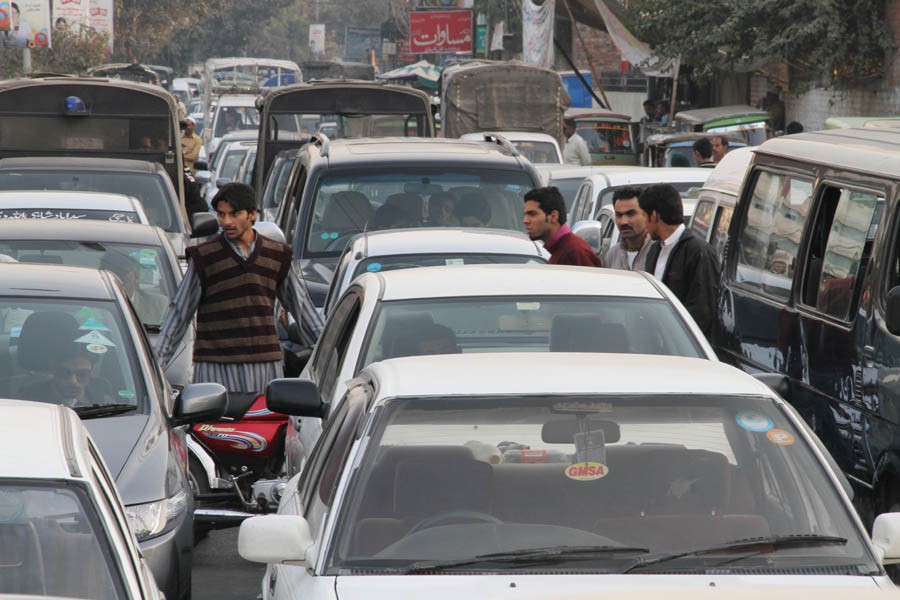
Despite tall claims and huge spending on remodelling of roads, chaos and traffic jams test the nerves of Lahoris

Despite spending billions of rupees on signal free corridors, remodelling of roads, flyovers, underpasses, warden system, digital traffic signals, e-traffic initiatives, Rapid Mass Transit Systems, Lahore Ring Road, worst traffic jams and chaos are the order of day.
Meet anyone in Lahore and they have nothing to say except complain about traffic.
The core problems -- haphazard commercialisation, spiral encroachments, scanty parking facilities, and unregulated slip roads and service roads -- stand unresolved over the last many decades. There are too many theoretical action plans; however, when it comes to deliver on practical grounds, everything falls flat.
In the view of Asif Saddiq, Superintendent Police traffic (city division), "even if modern innovations are introduced in traffic management system and roads are widened, traffic congestion and mess will continue to plague the city."
The solution, he says, lies in regulating, rather discouraging, commercialisation. "Almost all roads and junctions are marred by rampant commercial activities. When vehicles are parked on service road and main roads, how can the flow of traffic be maintained?" he asks, adding that parking facilities within the premises of buildings must be ensured.
He terms encroachment as mother of all traffic mess. "Footpaths, service roads, green belts and slip roads are completely occupied. In a situation, pedestrian traffic has no option but to spill on to roads that hurts vehicular movement. Even the cars, motorbikes, loaders, hand-pushed and animal-driven carts are forced to park on the main roads."
When asked about role of warden system introduced in 2006-07 in improving the traffic flow, he says "out of total number of 3200 wardens, around 2200 wardens are operating in the entire city whereas there should be around 6400 wardens".
The City District Government officials blame it all on people’s behaviour and mindsets. Nobody is ready to follow the rules and everybody is obsessed with haste hysteria. They suggest launching an extensive campaign to educate people about road usage.
"Almost 3 million motorised vehicle ply on road daily and growth is on upward trend," says Mazhar Husain, Director, TEPA. "Visualising the surge, the existing road network is being remodelled and revamped using digital trends. Signal free corridors have been experimented. Observing its efficacy and deliverability, more signal free roads may be planned out in future."
According to the JICA study on city transport and traffic issues conducted in 2012, the road network has many congested sections along arterial roads, which increases travel delay especially in the Canal road where commercial and trading activities are concentrated.
The study further says that car ownership was 18 per cent in 2010 and will be 44 per cent in 2030. The trend will further exacerbate the road traffic congestion. The forecast traffic volume will well surpass the road capacity by 2030, if no countermeasures are taken. It reveals that there is no segregation between markets and roads in Lahore. All roads are market places. Parking spaces are limited or non-existent in most of commercial shops and business buildings. Solutions to remove the encroachment will not be easy because it depends on a kind of social policy, study discloses.
The traffic laws, study discloses, are not applied on pedestrians, cyclists, animal-drawn carts and hand-pushed carts, even though these modes make up around 70 percent of the total road users. The typical traffic enforcement fines are quite low.
On a query, Dr Nasir Javed, CEO, Urban Unit says that traffic management and transport are correlated with each other. "The Urban Unit has designed and developed the Traffic Signals and Signs Manual, which is used almost on all road construction agencies, helping these into standardised signs .It has also designed, developed and published the Urban Roads Geometric Designs Manual, improving the designs of urban roads," he says.
In order to create parking facilities to ease out traffic problems, a Lahore Parking Company official says that "CDGL will release Rs100 million for mechanical rotary parking being planned in different places. In the first phase, 7 rotary parking sites will be operational byApril 2017".
Hafiz Nauman, LPC chairman, says that a survey has been finalised and the first rotary parking will start function in current month. "It would entertain 12 cars using the space required to park two vehicles. LTC has also planned parking spaces and plazas on Hall Road, Fane Road and at Ittefaq Hospital, Awain-i-Adl and Nila Gumbad."